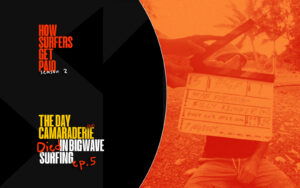Why Is There No Female Brazilian Storm?
A story involving sexism, cable TV shows, and a collapsed contest circuit.
It’s been 10 years since the term ‘Brazilian Storm’ was first coined.
It was invented by a beach announcer or by a commenter on Surfline—the origin story varies depending on who you ask. Either way, it was meant to describe the crew that took the 2011 Nike Lowers Pro by, well, storm. Six out of the eight quarterfinalists in the event were Brazilian, in a best-ever [at the time] collective effort from the nation’s surfers. Miguel Pupo beat Tanner Gudauskas in the final of the event and the rest is history.
Brazilians have claimed four World Titles since the Storm began. This year, the green, yellow, and blue flag sits beside the names of 11 out of the 34 surfers on the CT. Brazil went from being surfing’s poor cousin to its number one nation.
But, all of this is on the men’s side of the draw.
On the women’s side, the Storm has been borderline nonexistent.
Silvana Lima was the sole Brazilian woman on the CT for well over a decade. She’s the country’s best female surfer in history—having finished runner-up in 2008 and 2009—and she’s not done yet. Silvana secured a spot in the Tokyo Olympics and is still battling it out on the QS. However, at age 36, she belongs to the generation that came before the Storm. Ever since Silvana fell off the Tour, with the exception of Tatiana Weston-Webb, there have been no women representing Brazil on the CT.

“One of the reasons why there hasn’t been a female Brazilian Storm is because there have been virtually no women’s competitions in Brazil in the last decade,” says Silvana.
Up until 2011, Brazil had its own amateur, junior, and pro tours for both men and women. The economic crisis of 2008 depleted budgets and, from 2011 until 2018, there were no more female surf tours in the country—only the odd event here and there.
“Not having a tour had a huge impact on women’s surfing,” continues Lima. She explained that it not only stripped the younger generations of idols and perspective, but it caused many athletes to lose their only source of income.
“Take me, for example. I didn’t have any major sponsors at the beginning of my career—it was prize money that kept me going and made it possible for me to travel and compete overseas. I’d win more prize money in the international events and that kept the dream of making the CT alive. When we had a national tour, unsponsored athletes had a chance to make a living.”
But even before the crisis, things weren’t equal for men and women. “There was never the same level of investment in female surfers,” explains former competitor, professional freesurfer, and WSL South America Ambassador Marina Werneck. Women would get a check from sponsors and be expected to show up and perform in events, and that was that. Meanwhile the boys were being groomed for the CT. “For the men, there was always more money for surf trips, English lessons, Hawaiian seasons, and coaches.”

When the local comps ceased, competitors like Marina had no choice but to look overseas for events to compete in. “When I realized that my paycheck barely covered travel expenses and contest fees, freesurfing became a more attractive option than the QS,” continues Marina. “I could surf better waves, spend less money, and make my sponsors happy by producing content.”
The end of women’s competitions in Brazil coincided with the surf industry’s new approach to marketing. “I call it the sexualization of women’s surfing,” says Werneck.
Gradually, brands began sponsoring women for attributes other than their skill on a surfboard. Image became just as important as performance. Combine that with a non-existent contest scene and you have a scenario in which women who focused on winning events would be left behind.
“It was clear that surfer-models in Brazil were more successful, unfortunately,” says surf journalist Maíra Pabst. “Surfers who produced content for social media and television ended up taking most of the brands’ marketing budgets.”
Athletes were left with few options. “Without contests, we migrated to television,” explains Bárbara Müller, a former competitor and the current host of a TV show about women’s surfing, Maré das Marias. “We had support, but not for competition. Brands wanted to sponsor girls who not only surfed good, but would photograph well and represent the lifestyle.”

And that became the blueprint for the new generation, who ditched competition for TV shows, lifestyle ads, and content production. “It’s like a new segment of pro surfing was created,” reflects one of the best coaches in the biz, Leandro Dora. “Sponsored surfers started to make a living selling an image rather than performing in the surf.”
This wasn’t exclusive to Brazil—it was an international trend. But the impact for women in Brazil was dramatically enhanced by the loss of the national competition circuit.
“We actually had a female Brazilian Storm generation,” says former pro and celebrated surf journalist, film director, and podcast host, Julio Adler. “But it was buried and forgotten in the northeast of Brazil [one of the country’s poorest regions]. Women like Diana Christina and Alcione Silva, for example, surfed incredibly well. They were aggressive and progressive—like the female versions of Ítalo and Filipe—but they didn’t fit the aesthetic expectations of our terribly sexist society.”
Sponsorship dollars became increasingly scarce for women who didn’t have the stereotypical look and sex appeal. Without sponsors or prize money, professional surfing became impractical for them to pursue.
However, according to Werneck, the sexualization of women’s surfing had one positive aspect. “When I first started competing, we were always being compared to the men,” she explains. “When we surfed well, we surfed ‘like a guy.’ Being feminine wasn’t considered a good thing. When the shift in marketing happened, all of the sudden it was OK to be feminine. We could finally say: ‘We don’t wanna surf like the guys. We surf like girls, and we fucking rip.’”

This change has had an impact on women’s surfing in Brazil, but it has been far outside the competitive space. “The emergence of action sports focused cable TV channels brought a lot of visibility to women’s surfing and inspired more women to pick it up,” says Claudia Golçalves, a former pro and TV presenter for Canal OFF. “But being a recreational surfer and a pro are very different things.”
And the TV/lifestyle narrative is not without its critics.
“I think this shift to content production is a tremendous disservice to the sport,” says Julio Adler. “It’s always the same shallow, happy-go-lucky content, some road trip through Brazil, a surf trip to Central America, or something along those lines. Everyone is cute and happy and everything is removed from reality—all the while you have nobody telling the story of a struggling competitor here in Brazil, because sad stories aren’t cool.”
So while the men rose to the top of the rankings, Brazil’s best female surfers were on national TV stations instead of the world stage—with the exception, of course, of Silvana Lima.

“We had Silvana, and before her Jacqueline Silva and Tita Tavares—but they didn’t represent a movement, a generation,” says Alex Guaraná, former pro and editor of Brazil’s oldest [but now extinct] surf mag, Fluir. “They were simply freak talents who were lucky enough to find sponsorship at that specific time in their careers. The situation is so dire that today our best female surfer is Hawaiian.”
Tatiana Weston-Webb, who currently waves the Brazilian flag (a decision that seemed to coincide with surfing earning a spot in the 2020 Olympics), was born in Brazil but grew up in Hawaii. She has dual citizenship and is welcomed and celebrated in Brazil—but she’s undeniably a product of Hawaiian surfing. You can’t tie her success to Brazil’s competitive scene.
So, what would it take for a Brazilian woman to win a World Title?
“I think it’s up to us, the women, to raise the bar,” concludes Bárbara Müller. She partnered with surf photographer Amanda Ribas to launch Scape Praia Brava, a surf shop and brand focused specifically on women’s surfing. “Our ultimate goal is to support girls who represent Brazil on the World Tour.”

Since its inception a few years ago, Scape has held workshops and talks with young surfers. Müller says the results are already noticeable. “We see more and more girls in the water each year.”
But at the end of the day, a paradigm shift may be required.
“Women’s surfing needs to be taken more seriously by both the surfers and the investors,” says Claudia Gonçalves. “It needs to be more professional on both sides.”
For Brazilian women, a strong national competitive circuit is crucial for success on the world stage. But an industry that values and supports all sides of women’s surfing could prove to be even more important.














Comments
Comments are a Stab Premium feature. Gotta join to talk shop.
Already a member? Sign In
Want to join? Sign Up